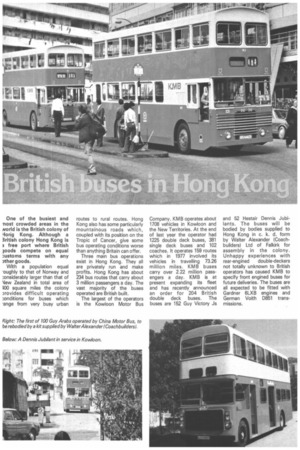One of the busiest and nost crowded areas in the
Page 78

Page 79

If you've noticed an error in this article please click here to report it so we can fix it.
NorId is the British colony of long Kong. Although a 3ritish colony Hong Kong is free port where British 3oods compete on equal ustoms terms with any Dther goods.
With a population equal • oughly to that of Norway and 3onsiderably larger than that of \Jew Zealand in total area of WO square miles the colony arovides difficult operating ;onditions for buses which 'ange from very busy urban routes to rural routes. Hong Kong also has some particularly mountainous roads which, coupled with its position on the Tropic of Cancer, give some bus operating conditions worse than anything Britain can offer.
Three main bus operations exist in Hong Kong, They all are privately run and make profits. Hong Kong has about 234 bus routes that carry about 3 million passengers a day. The vast majority of the buses operated are British built.
The largest of the operators is the Kowloon Motor Bus Company. KMB operates about 1708 vehicles in Kowloon and the New Territories. At the end of last year the operator had 1225 double deck buses, 381 single deck buses and 102 coaches. It operates 159 routes which in 1977 involved its vehicles in travelling 73.26 million miles. KMB buses carry over 2.22 million passengers a day. KMB is at present expanding its fleet and has recently announced an order for 204 British double deck buses. The buses are 152 Guy Victory Js and 52 Hestair Dennis Jubi!ants. The buses will be bodied by bodies supplied to Hong Kong in c. k. d. form by Walter Alexander (Coach builders)Ltd of Falkirk for assembly in the colony. Unhappy experiences with rear-engined double-deckers not totally unknown to British operators has caused KMB to specify front engined buses for future deliveries. The buses are all expected to be fitted with Gardner 6LXB engines and German Voith D851 transmissions. KMB operate on 84 per cent o.m.o. fleet with exact fare systems. The operator expects to have a total fleet seating capacity of 196,819 this year.
Second largest Hong Kong operator is China Motor Bus Co. which operates 70 routes on Hong Kong Island. CMB buses carry 0.66 million passengers daily. Like KMB, CMB buses operate on an exact fare system. Urban fares are 30, 40, or 50 Hong Kong cents and Suburban fares range from 30 cents to one Hong Kong dollar.
CMB had at the end of 1977 a licensed fleet of 751 vehicles of which 739 were double deck buses and 12 single-deckers. The China Motor Bus fleet is now 100 per cent one man operated.
CMB has a variety of British double deckers including Ailsas, Metropolitans, and Daimler Fleetlines. A large proportion of the fleet are Guy Arabs, some of which have been rebodied with kits supplied by Walter Alexander and Co. (Coachbuilders) Ltd. Among vehicles on order for CMB are Metrobuses, Ailsas Leyland Titans and a Dennis Dominator. CMB already has in service its first Metrobus which is now operating on normal bus duties.
A batch of 40 stretched 11 metre Metrobuses are also on order. These buses will have a seating capacity of 118 with 32 standees and will initially be used on cross harbour routes via the cross harbour tunnel.
CMB and KMB jointly operate a series of cross tunnel routes on a 50-50 pooled mileage basis. Over 350,115 passengers daily use the fourteen cross harbour routes which utilise 205 buses. Two all night cross tunnel services are run.
The third and smallest Hon Kong bus operator is the Lan1 Bus Company that operat( five routes on Lanto islanc This operator runs a fleet of 4 single deckers. Lanto island is holiday island and for th reason 30 per cent of th operator's passengers ar carried on Sundays and Bar holidays.
The Hong Kong Governmer subjects Hong Kong buses to similar system of licensing an Certificate of Fitness reguli tions as used in the Unite Kingdom although allowancE are made for extra passengr capacity. New buses in Hon Kong have to undergo a tilt tel in the same way as new bus( in England.
















































































































































































































